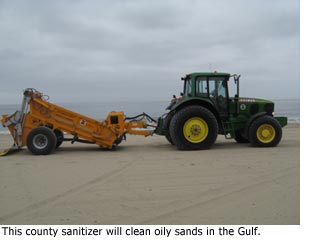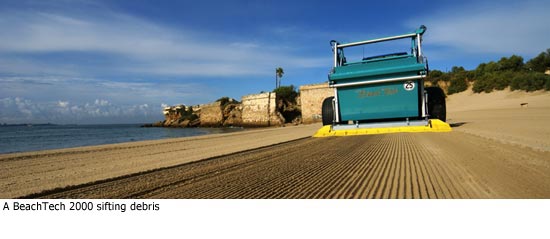An L.A. beachcomber heads south
September 7, 2010
Los Angeles County’s sandprint will soon be showing up on oily Gulf Coast beaches.
At the urgent request of BP, the county’s Department of Beaches & Harbors is finalizing a deal to send a BeachTech 2000 to Mississippi to help in the cleanup of the Gulf oil spill. The two-ton “sanitizer” ordinarily rakes and sifts cans, bottles and cigarette butts from county beaches near Redondo. Now it will see action sifting tar balls from barrier island beaches blackened by the giant oil disaster.
“We thought it was a great opportunity for the county to get involved and assist in the clean up,” said Ken Foreman, assistant chief of facilities and maintenance for Beaches & Harbors.
In exchange for the three-year-old unit, BP will buy the county a new replacement, valued at about $50,000. The Board of Supervisors unanimously approved a motion by Supervisor Don Knabe at Tuesday’s meeting to seal the deal. The new unit should arrive next month.
The unusual trade came because BeachTech couldn’t supply the sanitizers quickly enough for BP, explained Scott Merrill, manager of BeachTech’s North American operations.
BeachTech’s models work particularly well because, unlike other beach groomers, their rakes can be removed and sand can be sifted exclusively through a screen, Merrill said. Raking breaks up the globules of oil, making cleanup more difficult.
 Earlier this summer BP bought 25 BeachTech sanitizers after federal and state environmental officials determined that the equipment was effective. By late August, BP wanted 10 more, but BeachTech didn’t have the inventory to fill the whole order.
Earlier this summer BP bought 25 BeachTech sanitizers after federal and state environmental officials determined that the equipment was effective. By late August, BP wanted 10 more, but BeachTech didn’t have the inventory to fill the whole order.
Widely criticized for not reacting to the disaster swiftly enough, BP did not want to wait and asked BeachTech to call its best customers for loaners in perfect working condition.
“They said, ‘We don’t want cash for clunkers’,” Merrill said.
Besides L.A. County, four municipalities (three in Florida and one in Alabama) also agreed to send equipment. Clean up crews are using the equipment mostly at night and in the cool early morning hours, when the oily gunk is coolest, hardest and easiest to handle.
L.A. County’s yellow unit will be loaded on a truck later this week, most likely bound for unpopulated barrier islands off the Mississippi coast, where the beach cleanup is just getting underway. Foreman said that until L.A.’s new unit arrives, beach-cleaning crews will use other equipment.
“We should be okay for the time being,” Foreman said. “We didn’t want to miss the opportunity to help.”
Posted 9-7-10













 405 bridge work causes a stink
405 bridge work causes a stink
